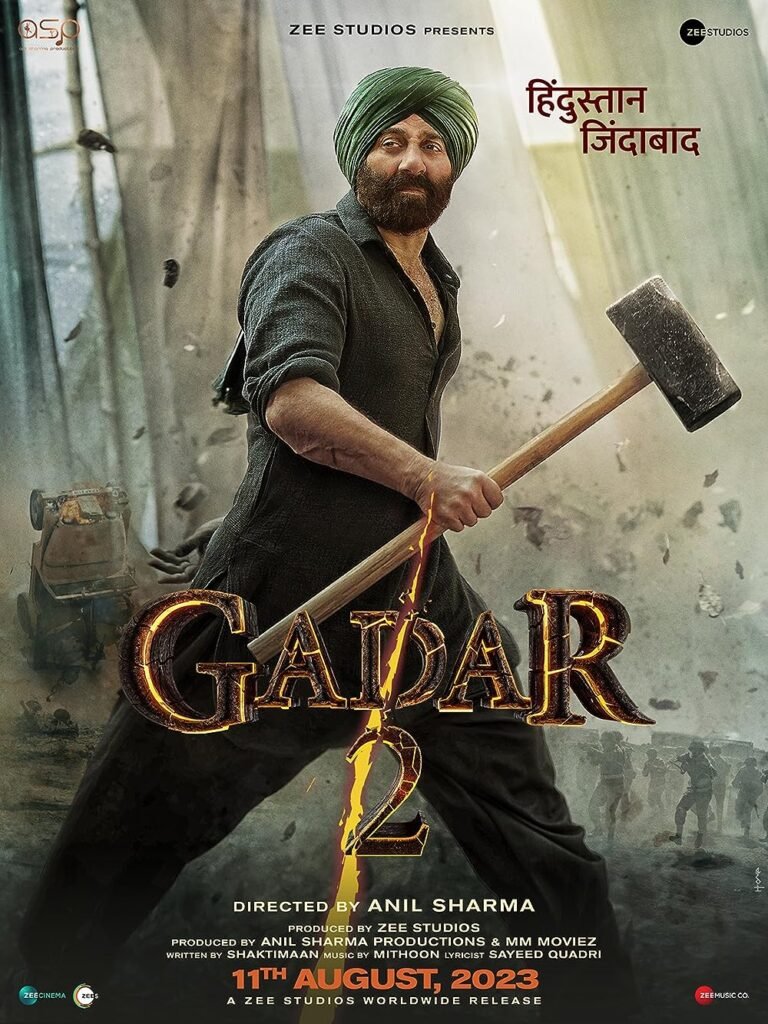With its expert use of classic cinematic techniques, the traditional Bollywood movie Gadar 2 has taken the box office by storm. Despite its adherence to a familiar formula, the film has sparked lively debates among film critics and raised questions about the changing tastes of modern audiences. If you’re someone who typically shuns formulaic films from the 90s, you may be intrigued by the fact that Gadar 2 has resonated with viewers.
While Mumbai filmmakers have faced challenges in adjusting to new trends, South Indian cinema has left a considerable mark on Bollywood. As a result, renowned actors such as Shah Rukh Khan, Salman Khan, Ranbir Kapoor, and Ranveer Singh have adopted the South Indian film style. Nevertheless, Karan Johar’s Rocky Aur Rani Ki Prem Kahani and Gadar 2 have remarkably revived the nostalgic essence of 90s Bollywood.

Gadar 2 reuses the fabric of the story and songs from the previous Gadar, with the only difference being that this time Tara Singh has to rescue his son from the army.
Gadar 2 may provide entertainment as a formulaic film, but it falls short in terms of logical storytelling, leaving director Anil Sharma’s creative abilities in question. It’s surprising that the same filmmaker who crafted the masterpiece Border could produce something as comical as Macross. Furthermore, while Indian films that criticize Pakistan often lack sufficient research, Gadar 2 takes this to an extreme under Anil Sharma’s direction.
In Gadar 2, Anil Sharma’s portrayal of Lahore contains major errors. Despite the ongoing conflict in East Pakistan and animosity towards India in West Pakistan, Sharma depicts Indian film posters on the city’s walls. This is a clear oversight, as Indian films were not allowed in Pakistan at the time and VCRs had yet to be invented. Instead, Pakistani film posters should have been used to accurately represent the city. It’s disappointing that the production didn’t allocate enough resources to ensure authenticity.

Listen to the second joke. There is an atmosphere of war in East Pakistan. Hatred in Pakistan for Sheikh Mujeeb was at its peak but see the director’s stupidity that there are revolutionary posters of Sheikh Mujeeb in Lahore and no one is asking. In an attempt to spew venom against Pakistanis, Anil Sharma instead tried to prove the value of freedom of expression and democratic traditions in Pakistan that even in circumstances like the fall of Dhaka, there was freedom to put up posters of Sheikh Mujeeb in Lahore.
The film portrays a Pakistan Army Major General as a terrifying villain who has been waiting for Tara Singh for 24 years, doing all the work himself like an investigating officer. He is in every scene because he is the main villain. However, this portrayal seems unrealistic and lacks authenticity. Anil Sharma needed to do some research on the army discipline and working methods to make the film more believable. As a filmmaker, it is important to ensure that the audience does not laugh at the film’s unrealistic portrayal.
- MCB Bank, PITB and Mastercard to collaborate on PayZenand Enhance Digital Payment Landscape in Pakistan

- Arts Council pays tribute to Sultana Siddiqui for her excellence in the media Industry

- A significant revelation about the marriage of Humayun Saeed and Samina

- Coke Studio season 15 releases “blockbuster”

- The importance of the RAILBUS for the city of Karachi.

In one scene, hundreds of Pakistanis with swords follow Tara Singh (Sunny Deol), but retreats when he approaches a hand pump. They had seen Gadar-Ek Prem Katha and knew he could create a flood with a hand pump.
In order to meet the director’s expectations, Sunny Deol took matters into his own hands and forcefully removed the electric poles. Moreover, he exhibited immense strength by using the pole as a weapon to vanquish his adversaries with ease.

Bullet-Proof, Current-Proof and Bomb-Proof Sunny Deol’s most brilliant stunt comes in the climax of the film when Bollywood’s new superhero Tara Singh single-handedly destroys several Pakistani tanks. Sunny Paji doesn’t even heat up. After this film, Paaji qualifies directly to take command of the Indian Army in Occupied Kashmir. All the problems can be solved if Sunny Deol is sent there alone by giving leave to Indian soldiers who are fed up with duty and commit suicide in Ladakh and Srinagar.
In Gadar 2, the hilarity continues with a comedic scene showing the lavish decoration of a large mandap for the stoning of Tara Singh’s son. However, it raises the question of whether Anil Sharma, the director, is aware that public courts do not exist in Pakistan for such punishments.
In this scene, a Maulvi Sahib (Religious leader) orders the stoning of Tara Singh’s son Jeeta, and the court is set up in the middle of the intersection as if an Orbital Monkey is performing. Spectators were also gathered to watch the proceedings of this court. Then Tara Singh comes and destroys the whole court and both father and son manage to escape from thousands of bullets. India’s idiotic audience would love to see all this but to the world, this scene is beyond laughable. Anil Sharma could have done so much homework by interviewing Abhinandan who came to Pakistan to drink a mug of tea in exchange for the destruction of a MiG-21 Bison. Hopefully, next time, while making Gadar 3, Anil Sharma will study the Kulbhushan Yadav case to make the audience laugh less and entertain more.
The film takes a jab at the Indian Army, portraying them as ill-equipped in comparison to their Pakistani counterparts during their competition on Ram Tekri. The Indian Army is shown to lack a hero to transport their weapons and ammunition to the mountain’s peak, requiring the assistance of Tara Singh and his truck. Additionally, the film acknowledges the capture of numerous Indian soldiers as prisoners of war by Pakistan on the Ram Tekri front.




Jeeta, son of Tara Singh, embarks on a journey to Pakistan in search of his father, sporting a beard as he makes his way. However, he encounters a challenge posed by Bollywood’s inaccurate portrayal of Pakistan and its people. The film industry perpetuates ignorance about the country, leading its audience to believe that Pakistan is an Arab state, or a country akin to Afghanistan. Meanwhile, Indians tend to view themselves as the most knowledgeable people in the world, believing that they possess a greater understanding of global affairs than anyone else.
The film promotes the concept of Ghazwa Hind (The Great War). The film depicts Indians living in constant fear of a potential invasion by Pakistan. Meanwhile, Pakistanis have only heard about this threat through Zaid Hamid‘s videos. Some may wonder if Anil Sharma, the director, is provoking Muslims to invade India. The creators of Gadar 2 hold the answer to this question.
On the one hand, the film tries to prove Muslims, especially Pakistanis, as extremists, and on the other hand, Qurban Khan (a Pakistani Muslim) is seen begging Tara Singh to marry his daughter to a Sikh.
The constant presence of flags on every street and rooftop gives the impression that the entire movie was filmed solely on August 14th. It’s amusing to see posters of Tara Singh and her son plastered all over the city in search of them, but it raises the question of why a Major General’s picture is included. Only the film director knows the reason behind it. In reality, people in Pakistan don’t typically have knowledge of serving Major Generals. This once again highlights the lack of thorough research conducted by Anil Sharma.
Despite its flaws and weak points, Gadar 2 has succeeded in one key aspect: its anti-Pakistan subject matter has resonated with Indian audiences. This success challenges the assumption of a connection between India and Pakistan and serves as a concrete example to clear any misconceptions held by Pakistanis. While the film may not excel in other areas such as music or star value, its impact on anti-Pakistan sentiment cannot be ignored.

Gadar and Gadar 2 attempt to prove that Indian Punjab is the enemy of Pakistani Punjab. The film’s superhero, Tara Singh, is only spreading Gadar in Lahore. The previous Gadar portrayed Tara Singh abducting his Muslim wife, Sakina, from Lahor and forcing her to become a Sikhni, fathering a child with her. Gadar 2 continues this theme with Tara Singh’s son, Charanjit Singh, falling in love with a Muslim girl from a Punjabi family. The film boldly addresses historical accusations against the Sikhs in the wake of the 1947 migration.
Despite the other factors at play, it is important to focus on the acting department of Gadar 2. Sunny Deol has struggled to achieve a hit in recent years, but this film has brought him back into the game. Director Anil Sharma deserves credit for Sunny’s success in carrying the film. Ameesha Patel impresses in her new role as a character actor. Utkarsh Sharma, who plays the traditional hero, has potential but still needs to develop his acting skills. Samrat Kaur delivers a strong performance in her debut role, while Luv Sinha, unfortunately, goes to waste. Overall, the rest of the cast gave adequate performances.

The technical elements of the film, including the cinematography and editing, are praiseworthy.
Regarding the film’s music, it’s worth noting that most of the songs featured are from the 2001 release. While the new tracks are also worth a listen, they don’t quite capture the same captivating melody as classics such as “Main Nikla Gudi Le Ke” or “Udja Kale kanwaan.”
At present, Ghadar 2 has surpassed its business target of Rs.350 crores at the box office. However, whether this achievement marks the end of Bollywood or the start of a new era remains to be seen in the coming months. We await the answer.







